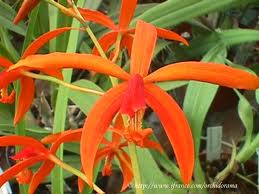Lobivia
This group of cacti is native to Bolivia. These small, globular or cylindrical cacti produce an abundance of colorful flowers that seem as large as the plant. L. argentea forms large clumps of stems up to 4 inches high with a diameter of 6 inches. They are shiny or grayish-green and have 24 ribs that curve and diverge with age. The tuberculate ribs have sharp edges and are armed with 14 radial spines and a 3-inch central spine. The downy areoles grow in the depressions between the tubercles. Its flowers are silvery white to a pinkish lilac. L. cinnabarina forms a spherical stem, 6 inches in diameter. It has 20 ribs spirally arranged with raised tubercles between which the areoles appear. Their brownish spines turn grayish eventually. Their deep crimson flowers are 11/2 inches across and just over an inch long and stay open for two days. L. famatimensis has an oval stem about 11/2 inches high. The 18 to 24 tuberculate ribs are covered with numerous, short, white, crisscrossing spines. The flowers grow up to 11/2 inches long and have a fuzzy, scaly tube. The outer petals vary from cream to red generally darkening towards the center.
Pot Cultivation
These cacti need a minimum temperature ranging from 32� to 42� F, depending on the variety. They need good light (not harsh, direct summer sun) and cooler temperatures during the winter; too warm can hinder flowering. Grow them in rich, porous, sandy soil and let the soil dry out between waterings. Repot in the spring when their roots become cramped. Generally, they should be repotted every other year in order to provide fresh soil. However, this doesn't necessarily mean they'll need a larger container. Fill about a quarter of the pot with broken crocks, gravel, etc. to promote good drainage. Firm the potting soil. After repotting don't water for a week or more.
Propagation
Lobivias can be increased by seed, cuttings, or basal shoots. Seeds may be sown in containers filled with a general-purpose cactus and succulent potting mix. Sprinkle the seeds evenly over the surface of the compost. Cover the seeds lightly with some grit, moisten the container and place in an area with high humidity and warmth. Transplant the seedlings when they are large enough to handle. Waiting too long until they are overcrowded can cause rot. Gently separate them so as not to damage the delicate roots. Transplanting will be easier if the soil is slightly moist. Seedlings can be potted singly or with several to a pot. They seem to do better with a few together than by themselves. Cuttings can be taken by detaching a healthy stem with a sharp, sterile knife. Leave the cutting in a warm, dry place for a couple of days or weeks until a callus forms over the wound. Once the callus forms, the cutting may be inserted in a container filled with firmed cactus potting mix topped with a surface layer of coarse grit. They should be placed in the coarse grit only; this prevents the cut end from becoming too wet and allows the roots to penetrate the rich compost underneath. The cutting should root in 2 to 6 weeks.
 |
|
| L. cinnabarina |
|
VARIETIES
- L. binghamiana;
- L. caespitosa;
- L. pentlandii;
- L. argentea;
- L. aurea;
- L. backebergii;
- L. boliviensis;
- L. cinnabarina;
- L. famatimensis & var. setosa, densispina;
- L. mistiensis;
- L. rebutioides
- L. rossii;
- L.shaferi;
- L. silvestrii;
- L. jajoiana;
- L. winteriana;
- L. shieliana;
- L. arachnacantha
- L. bruchii;
- L. formosa.





